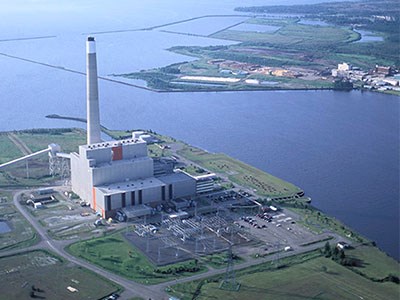Ontario's leading power regulator has ruled the Thunder Bay Generating Station must run for the balance of this year.
The July 25 decision by the Ontario Energy Board (OEB) is providing hope in northwestern Ontario that a mothballed conversion process to switch the power plant from burning coal to natural gas will be re-ignited by the province.
The OEB ordered the Integrated Electrical System Operator (IESO), which dispatches power across the province, to enter into a contract with Ontario Power Generation (OPG), to keep one of two generating units at Thunder Bay for the rest of 2013 under what's called a Reliability Must Run contract.
That was sweet news for Larry Hebert, co-chair of the Common Voice Northwest Energy Task Force, a regional lobby group, who believes the decision bodes well for the future.
“It means the OEB recognizes that this plant has to run,” said Hebert, the former general manager of Thunder Bay Hydro. “We're still awaiting a decision on whether the gas conversion is going to go ahead and we think it's quite necessary.”
He's confident a second contract could be in the offing since the board encouraged OPG to apply soon for 2014.
The suspension of the plant conversion sparked controversy last fall after the Ontario Power Authority decided it wanted to “explore other options for electricity supply” in the northwest. Regional leaders and the task force vehemently argued with the province about a looming power supply crunch if new mining operations spring into production over the next few years.
Hebert expects the province to make a final decision on whether the conversion will proceed in the coming weeks.
“I talked to (Northern Development and Mines Minister Michael) Gravelle and he said, we're getting very close to a decision,” said Hebert. “We're anticipating the end of August.”
When contacted, Gravelle was mum on a date, preferring to leave it in the hands of energy minister Bob Chiarelli who is “aware that a decision must be made soon.”
“As minister, I'm conscious of some of the opportunities we're going to be seeing for mines opening up in the couple of years, and that is outside of the Ring of Fire.”
Gravelle, the MPP for Thunder Bay-Superior North, said Chiarelli has assured him that the region's future energy needs “will be met.”
“I'm absolutely confident that the right decision will be forthcoming from the minister.”
With the OEB's ruling in hand, Gravelle said he planned to follow up with Chiarelli at an Aug. 7 cabinet meeting.
Hebert's task force has determined the northwest's demand for power will grow to 1,600 megawatts by 2020, fueled mainly by the growth in the mining sector. They argue a beefedup East-West transmission corridor is needed but also a fully functioning Thunder Bay Generating Station. Hebert said the proof was in a cold spell last winter when the plant ran at full capacity, 167 megawatts, to supply power just to Thunder Bay when power was in short supply on the Ontario grid.
“Because 2013 has been settled, they've got to run in 2014 or they're out of power again. I think it's going to work out well.”
Gravelle praised the task force for mounting a strong case that ultimately influenced the energy board's decision.
“I think it's important that we use the power that's generated in Northern Ontario if at all possible.” He acknowledged that the East-West line is an important improvement but it won't be operational until 2017-18 which could lead to power supply problems.
“I believe that's well understood by the Ministry of Energy.”
The group has clashed with the Ontario Power Authority, the province's long-term power planners, over each other's respective forecasts for the northwest.
Hebert said although both parties are closer on the numbers, the only sticking point is the OPA feels, if needed, more power can be imported from Manitoba and the U.S., an argument Hebert strongly disputes.
“We talked to Manitoba Power and they told us (because of contractual obligations) the first available power from them is the mid- 2020s.”
Hebert expects all available power in the U.S. Midwest to be gobbled up by new mining activity on the Minnesota iron range and the coming development of the Bakken oil fields, a huge reservoir beneath Montana and North Dakota.




